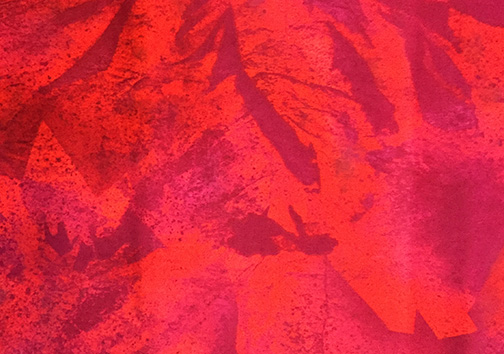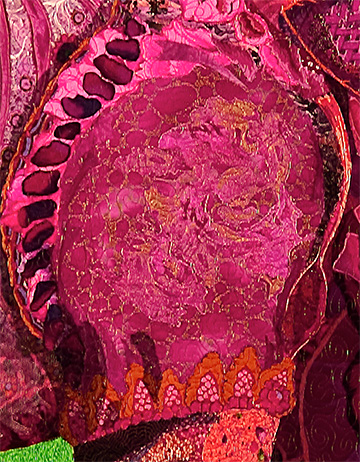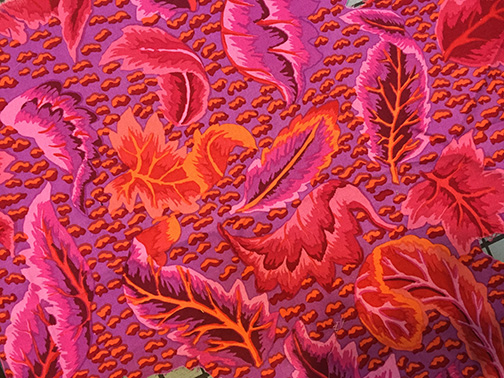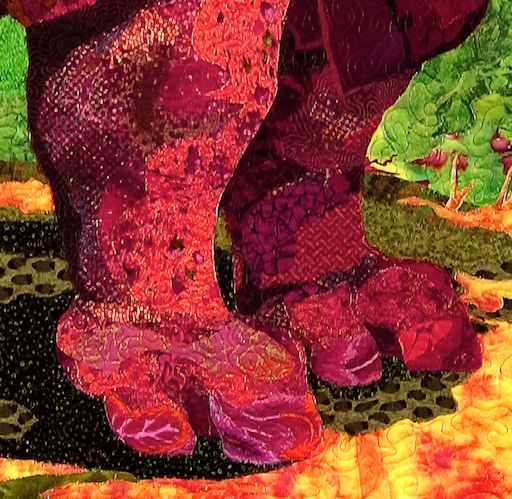Before I was the crocodile quilt lady, I was known by some as the pink rhino quilt lady.
Between teaching, home life, and other commitments, I have averaged one big piece per year for about a decade—so certain quilts have defined entire portions of my career. “Tickled Pink” qualifies as one such quilt. It continues to have an impact to this day, drawing attention to itself and to me as an artist and teacher. Part of its appeal I think is that it’s such a surprising image. A rhino dressed in flamingo pinks isn’t something you see every day.
This quilt is the perfect example of why I hesitate to answer when someone asks how long it takes to create a quilt. On the simplest level, the question is asking how much time did I spend cutting, gluing, assembling, and quilting. That’s what most people want to know and often I can’t even answer that simple question as I don’t keep track of the time.
But a more interesting and complicated answer to the question involves seeking out the origin, the moment of inspiration, then tracing the events that lead up to actually sitting down and creating the quilt. Some paths to creation are short—then there’s “Tickled Pink.”
How long did it take to make “Tickled Pink”? Answered one way, it took six very intensive weeks. Answered another, it took three decades.
Three Decades
I first encountered Albrecht Dürer’s work in high school art class. That’s when I learned about the 16th century engraver’s art, including paintings, engravings, and woodcuts. That’s when I first saw his “Rhinoceros.”
I fell in love, with the image, with Dürer’s work, and with woodblock printing in general. I gave my Dad a copy of Dürer’s watercolor, “Young Hare.” I even made a woodblock homage of his rhino, “Unicorn” (Remember, this was high school. And don’t ask me why I thought unicorns had horns on their noses).

Fast forward 30 years.
In 2005, while on a work trip, my host had a copy of the print, reminding me of how much I had liked it. Later that week we visited a fabric store, as I am wont to do whenever I travel. They’d received a recent shipment of a new line of fabrics. One of them was a luscious pink and orange that immediately reminded me of armor. I took that and an armful of other bolts of pink fabrics to the counter to be cut. The employee there asked me, in a conversational way, what I was making. “A pink rhinoceros,” I said. Talk about a conversation stopper!
Below I show how I used some of those hot pinks, light reds, and oranges.









That was the moment of inspiration, picking up the pink fabric that reminded me of armor, but it took me over a year and a half collecting fabric before my palette was fleshed out enough so that I could consider beginning.
Six Weeks
As is common with me, however, it was a deadline that finally got me started. Portsmouth Fabric Company, where I had once worked as manager, invited me to participate in a Kaffe Fassett show/challenge. The challenge was that the quilt had to use some of Fassett’s fabric. The catch was I would have only six weeks to complete the piece. At first I declined, but the owner, Gretchen Rath, wouldn’t take no for an answer. (Thanks, Gretchen.)
So I told my husband, Tom, “If I’m going to do this, you’re going to have to do everything else.”
House, eight-year-old, pets, meals, etc.
I would work all day, come in to eat the meal he’d prepared, go back to work, come in for a few hours of sleep, then go back to work. In six short (or long depending on whether you ask me or Tom) weeks, just in time for the show at Portsmouth Fabric, the piece was complete.
So you can see, decades of experience led up to that moment of inspiration in the fabric store. When I saw that pink fabric, Albie (as “Tickled Pink” is nicknamed after Albrecht Dürer) was already a part of my consciousness. That’s why I saw a rhino and not an armadillo or a tortoise.
So how long did it take to make “Tickled Pink”?
It depends.
The Next Decade
Albie’s influence on my career continues today.
He opened my eyes to a whole new category of subject matter. I’d started with portraits, moved on the fish, and then bugs and butterflies. This, the first large animal I made, opened up an entire new field of subjects. After he was done, I soon wrote a list of animals I thought would be interesting to create.
This was written on my day planner almost 10 years ago, under the heading “Specimens,” as I am planning to title an exhibit of my large-animal work. Though some in the list are still waiting for their chance on my pinning wall, I have since completed a dodo and a fruit bat and scarab beetles and even Stevie the crocodile.
Also included under “Sunday” is a list of pet quilts. Pippin has been memorialized in “Dixie Dingo Dreaming.” But Daisy (Bat-Faced Lover Dog), Hassan (Golden Boy Happy Dog), and Max (Intrepid Tiger Cat) are still waiting for their turns. Got some work to do yet.
“Tickled Pink” will always be a signature piece for me. He’s big, he’s bold, he’s got a horn on his nose. Thanks to him, I’ll be adding to my animal menagerie for as long as I can foresee.



Thank you. Love your entries as they inspire me.
Seeing a post from you on FB always makes my day!
Thanks for making my day!
What a wonderful answer to the question we are asked so frequently….how long did it take…etc. So many times It is just a germ of an idea or random thought that sticks with you. Thanks for sharing your thoughts!
I will always remember Albie from the very first time I saw him. I have never seen him in person but in books, magazines and on TV. Thank you for sharing your creative process with us. I just finished a quilt from a drawing I made in the 70’s, and painted in the 90’s of my son who hasn’t been a toddler for over 43 years. It just isn’t time until it is time.
Susan, your work if so inspiring. So, let me ask you, when do you find the time to even write a newsletter, and “how long does it take you”?!!!
Hi Betty – I miss seeing you at Asilomar! Take care.
Thanks Sue!
How true Sharyn.
Love the Durer and seeing how you used the fabrics
Thank you Susan, it’s a very inspirational post and the rhino is beyond words!
This rhino is a truly incredible quilt!!
You are the source of my intro into all things fabric! You are my muse and mentor. Thank you for bringing me to the place where I belong.
Saw this today at the Kaffe Fassett exhibition in Edinburgh. Wonderful piece of work.
Hi there
I recently saw your stunning rhino quilt in Quilt inspiration & am wondering how can I purchase the pattern? My sister is a crazy rhino fan, with figures of them all over her home & I thought getting a quilt made for her would be the ultimate in a gift. I have had no luck contacting you with the addresses quilt inspiration gave me, so hopefully this one might work.! I look forward to hearing from you soon. Thanks in advance ????
Shayne
Sorry, Shayne. There is no pattern for the rhino. However, Tickled Pink was inspired by a woodcut print by Albrecht Durer and is not the only quilt inspired by Durer’s rhino. There are several others out there and each is a unique work of art interpreted by the artist. You are free to make your own version if you wish. All the best, Susan